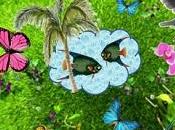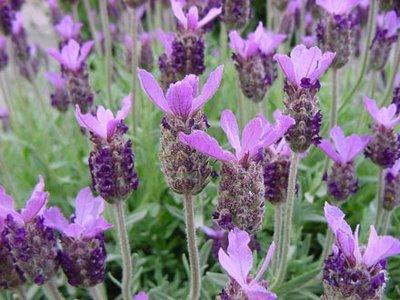
The so called "French lavander" is an attractive and unusual lavender from hot, dry Mediterranean regions, and best grown in a warm position, sheltered from cold winds and frost if you are living in a continental climate.
It is an old variety, cultivated for more than 400 years, and a favourite both for its intense fragrance and also the short dense flower spikes topped with a flourish of conspicuous rich violet bracts, rather like a set of extravagant ears. The Royal Horticultural Society has given it its prestigious Award of Garden Merit (AGM).
It is not fully hardy, but survives well in a sunny corner or against a warm wall, and makes an excellent container plant that can be brought under cover in winter.
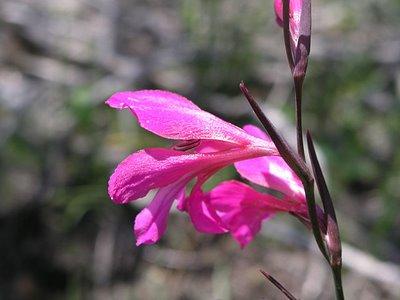
Illyrian Gladiolus is a winter hardy dwarf species native of the Mediterranean, growing in rocky, sun-exposed sites. Makes showy, quite large, dark lilac flowers with white streaks on lower petals on short stems. Easily cultivated in any rich, very well drained soil in full sun. Seeds from a wild collection in Southwestern Mallorca, Spain (La Trapa, 250m). In Spain, it's a protected species.
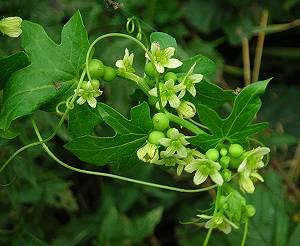
Bryonia dioica belongs to the section of the genus Bryonia, with palmately lobed leaves. It is common among the hedges and in the borders of woods in Europe, especially in the calcareous soil of some parts of England, where it is quite ornamental. The stem, which is a rough annual, climbs to the height of several feet above hedges and undershrubs; the leaves are cordate and 5-lobed, the terminal lobe being longer than the others, and dissimilar. The flowers are of a light, greenish-white color, with darker green veins; they are perfectly dioecious in the young plants, although both sexes are often found on older individuals. The fruit is a bright scarlet berry (red bryonia), with several flat seeds. Bryonia has been used in medicine throughout sections of Europe for a great many years, and occupied a conspicuous place in the London Dispensatory, published in 1653. It is vulgarly known as snakeweed, devil's turnip, parsnip turnip, and bastard turnip. The root, the part employed, is from 2 to 4 inches in diameter, and about 2 feet in length, although occasionally larger. It is fleshy, and when wounded, yields a milky juice. Internally it resembles the root of Phytolacca decandra, maintaining the similarity when sliced and dried.
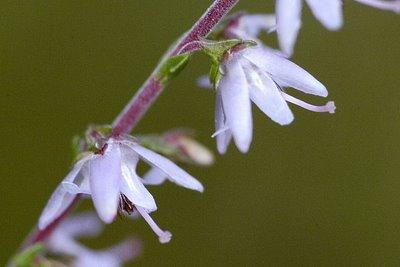
Calluna vulgaris is an evergreen, fully hardy bushy shrub which grows up to 30 cm in height though it is generally more compact amongst the cultivars. Foliage may be any shade of green, the autumnal hues of yellow and russet, or even grey. Spikes of urn-shaped single or double flowers run from white, through pink and mauve to ruby and deep purple, appear in mid-summer and persist until late autumn.
Native to the open uplands, these plants create a superb carpet for a moist but free-draining sunny bank.
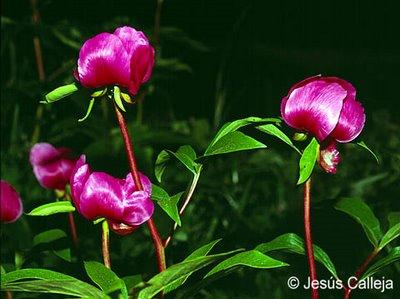
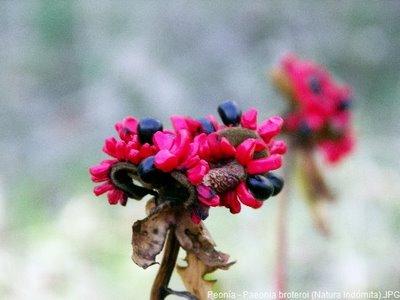
Paeonia broteri is a fabulous species, limited to the Iberian peninsula from whence it was described as long ago as 1842 and it's now a protected species. It makes stems up to about 45cm tall with leaves, each divided into 10-20 narrowly elliptical, glabrous segments.
Above the foliage are held freely produced, bowl shaped flowers of bright pale pink, these tone to deep pink-rose at the petals edges whilst the whole bloom is contrasted with a central golden boss. Individual blooms can be from 8-15 cm in diameter. Under the flowers are densely tomentose follicles.
Becoming rare in the wild as progress and agriculture push back its already sparse distribution, it is now limited to the mountain areas of Spain and Portugal, but though rare it is totally growable, our plants stem from a long- established horticultural stock.
Garden soil, leaf enriched for best results, light shade and a site sheltered from strong winds.
